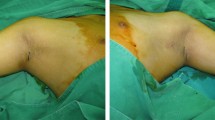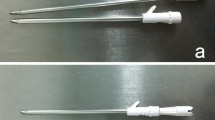Abstract
Background
Axillary osmidrosis results in social and psychological problems. Liposuction-assisted techniques used as treatments have been reported to have high recurrence rates. This study aims at introducing the aggressive suction–curettage technique in comparison to the open excision procedure.
Methods
From February 2009 to February 2014, 130 patients were randomly divided into two groups (experimental and control groups). The experimental group was treated with aggressive suction–curettage, while the control group was treated with an open excision. Postoperative assessment (skin necrosis, hematoma, scars and malodour recurrence) and patient satisfaction were surveyed and analyzed.
Results
A lower necrosis rate was observed in patients who received aggressive suction–curettage (1.88 %, p < 0.01), higher patient satisfaction (33.85 %, p < 0.01), higher recurrence rate (11.54 %, p < 0.05), and less ugly scars (0.77 %, p < 0.01), compared to those who had the open excision procedure.
Conclusions
The aggressive suction–curettage technique appears to be a reliable treatment option for axillary osmidrosis.
Level of Evidence II
This journal requires that authors assign a level of evidence to each article. For a full description of these Evidence-Based Medicine ratings, please refer to the Table of Contents or the online Instructions to Authors www.springer.com/00266.










Similar content being viewed by others
References
Hamm H, Naumann MK, Kowalski JW, Kutt S, Kozma C, Teale C (2006) Primary focal hyperhidrosis: disease characteristics and functional impairment. Dermatology 212:343–353
Bechara FG, Gambichler T, Bader A, Sand M, Altmeyer P, Hoffmann K (2007) Assessment of quality of life in patients with primary axillary hyperhidrosis before and after suction-curettage. J Am Acad Dermatol 57:207–212
Jeong JH, Hong JM, Pak CS, Kim JH, Heo CY (2014) Treatment of axillary osmidrosis using a laser with a 1444-nm wavelength. Dermatol Surg 40:851–857
Xie A, Nie L, Tan Q (2014) Local injection of botulinum toxin A: an alternative therapy for axillary osmidrosis. J Dermatol 41:153–156
Tsai RY, Lin JY (2001) Experience of tumescent liposuction in the treatment of osmidrosis. Dermatol Surg 27:446–448
Lee D, Cho SH, Kim YC et al (2006) Tumescent liposuction with dermal curettage for treatment of axillary osmidrosis and hyperhidrosis. Dermatol Surg 32:505–511
Kim WO, Song Y, Kil HK, Yoon KB, Yoon DM (2008) Suction-curettage with combination of two different cannulae in the treatment of axillary osmidrosis and hyperhidrosis. J Eur Acad Dermatol Venereol 22:1083–1088
Kim HG (2014) A new osmidrosis procedure, the scrape and suction technique: review of 4,322 patients. Aesthet Plast Surg 38:282–287
Huang YH, Yang CH, Chen YH, Chen CH, Lee SH (2010) Reduction in osmidrosis using a suction-assisted cartilage shaver improves the quality of life. Dermatol Surg 36:1573–1577
Liu Q, Zhou Q, Song Y, Yang S, Zheng J, Ding Z (2010) Surgical subcision as a cost-effective and minimally invasive treatment for axillary osmidrosis. J Cosmet Dermatol 9:44–49
Perng CK I, Yeh FL, Ma H, Lin JT, Hwang CH, Shen BH, Chen CH, Fang RH (2004) Is the treatment of axillary osmidrosis with liposuction better than open surgery? Plast Reconstr Surg 114:93–97
Grazer FM (1992) A noninvasive surgical treatment of axillary hyperhidrosis. Clin Dermatol 10:357–364
Beer GM, Baumüller S, Zech N, Wyss P, Strasser D, Varga Z, Seifert B, Hafner J, Mihic-Probst D (2006) Immunohistochemical differentiation and localization analysis of sweat glands in the adult human axilla. Plast Reconstr Surg 117:2043–2049
Lee YJ, Suh MS, Lee JH, Park JW, Cho BC, Baik BS (2001) Combination treatment of osmidrosis by liposuction and endoscopic shaver. Korean Soc Plast Reconstr Surg 28:517–521
Bechara FG, Sand M, Hoffmann K (2007) Tumescent liposuction with dermal curettage for treatment of axillary osmidrosis and hyperhidrosis. Dermatol Surg 33:125
Kao TH, Pan HC, Sun MH, Chang CS, Yang DY, Wang YC (2004) Upper thoracic sympathectomy for axillary osmidrosis or bromidrosis. J Clin Neurosci 11:719–722
Hsu CP, Shia SE, Hsia JY, Chuang CY, Chen CY (2001) Experiences in thoracoscopic sympathectomy for axillary hyperhidrosis and osmidrosis: focusing on the extent of sympathectomy. Arch Surg 136:1115–1117
Hsia JY, Chen CY, Hsu CP, Shai SE, Yang SS, Chuang CY (2003) Outpatient thoracoscopic sympathicotomy for axillary osmidrosis. Eur J Cardiothorac Surg 24:425–427
Acknowledgments
This project was supported by Grants from Zhejiang Provincial Natural Science Foundation (Grant No. Y2110414), and Zhejiang Provincial Department of Health Project (Grant No. 2014KYB090).
Conflict of interest
The authors declare that they have no conflicts of interest to disclose.
Author information
Authors and Affiliations
Corresponding author
Rights and permissions
About this article
Cite this article
Wang, C., Wu, H., Du, F. et al. Axillary Osmidrosis Treatment Using an Aggressive Suction–Curettage Technique: A Clinical Study on Paired Control. Aesth Plast Surg 39, 608–615 (2015). https://doi.org/10.1007/s00266-015-0490-z
Received:
Accepted:
Published:
Issue Date:
DOI: https://doi.org/10.1007/s00266-015-0490-z




